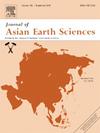Petrological and geochemical characteristics of Ordovician cherts in the Qasim Formation, NW Saudi Arabia: Understanding the roles of biogenic and volcanic activities
IF 2.7
3区 地球科学
Q2 GEOSCIENCES, MULTIDISCIPLINARY
引用次数: 0
Abstract
The Upper Ordovician Qasim Formation features bedded cherts with mudstone interbeds, which are overlain by Tertiary volcanic rocks. The origin and formation conditions of the cherts are almost completely unknown. To address these, this study employed thin-section petrography, XRF analysis, REE geochemistry, SEM analysis, and stable oxygen isotopes. Results of the study indicate that the cherts are primarily biogenic, derived from siliceous sponges, with contributions from terrestrial and river sources. Silica from marine upwelling and terrestrial sources enhanced biogenic activity, leading to the formation of the chert. Ratios of Si/(Si + Al + Fe) and Al/(Al + Fe + Mn) support a biogenic silica origin, while REEs suggest formation under oxic marine conditions (Ce/Ce* anomaly 0.3–1.0, avg. 0.7). The cherts also show an average Y/Ho value of 33.3, indicating marine influence with freshwater input. Diagenesis played a vital role in the formation of the cherts, with microcrystalline quartz replacing carbonate bioclasts and subsequently partly recrystallizing into blocky mega-quartz near chert-basalt contact. The microquartz cherts have δ 18O values of 26.7 to 33.7 ‰ (± 0.6 ‰), corresponding to formation temperatures of approximately 14 to 45 °C (avg. 38 °C; ±3 °C), whereas the mega-quartz chert has a δ 18O of 20.4 ‰ (±0.6 ‰), reflecting a formation temperature of approximately 115 ± 5 °C). These oxygen isotope values and temperatures reveal that the microquartz chert formed in cooler, shallow marine conditions, while the megaquartz chert was affected by a significant thermal event at the contact with the Tertiary basalt emplaced over the chert layers. These findings provide insights into paleoenvironmental conditions, thermal history, and the impact of later volcanic activity on chert recrystallization.
求助全文
约1分钟内获得全文
求助全文
来源期刊

Journal of Asian Earth Sciences
地学-地球科学综合
CiteScore
5.90
自引率
10.00%
发文量
324
审稿时长
71 days
期刊介绍:
Journal of Asian Earth Sciences has an open access mirror journal Journal of Asian Earth Sciences: X, sharing the same aims and scope, editorial team, submission system and rigorous peer review.
The Journal of Asian Earth Sciences is an international interdisciplinary journal devoted to all aspects of research related to the solid Earth Sciences of Asia. The Journal publishes high quality, peer-reviewed scientific papers on the regional geology, tectonics, geochemistry and geophysics of Asia. It will be devoted primarily to research papers but short communications relating to new developments of broad interest, reviews and book reviews will also be included. Papers must have international appeal and should present work of more than local significance.
The scope includes deep processes of the Asian continent and its adjacent oceans; seismology and earthquakes; orogeny, magmatism, metamorphism and volcanism; growth, deformation and destruction of the Asian crust; crust-mantle interaction; evolution of life (early life, biostratigraphy, biogeography and mass-extinction); fluids, fluxes and reservoirs of mineral and energy resources; surface processes (weathering, erosion, transport and deposition of sediments) and resulting geomorphology; and the response of the Earth to global climate change as viewed within the Asian continent and surrounding oceans.
 求助内容:
求助内容: 应助结果提醒方式:
应助结果提醒方式:


